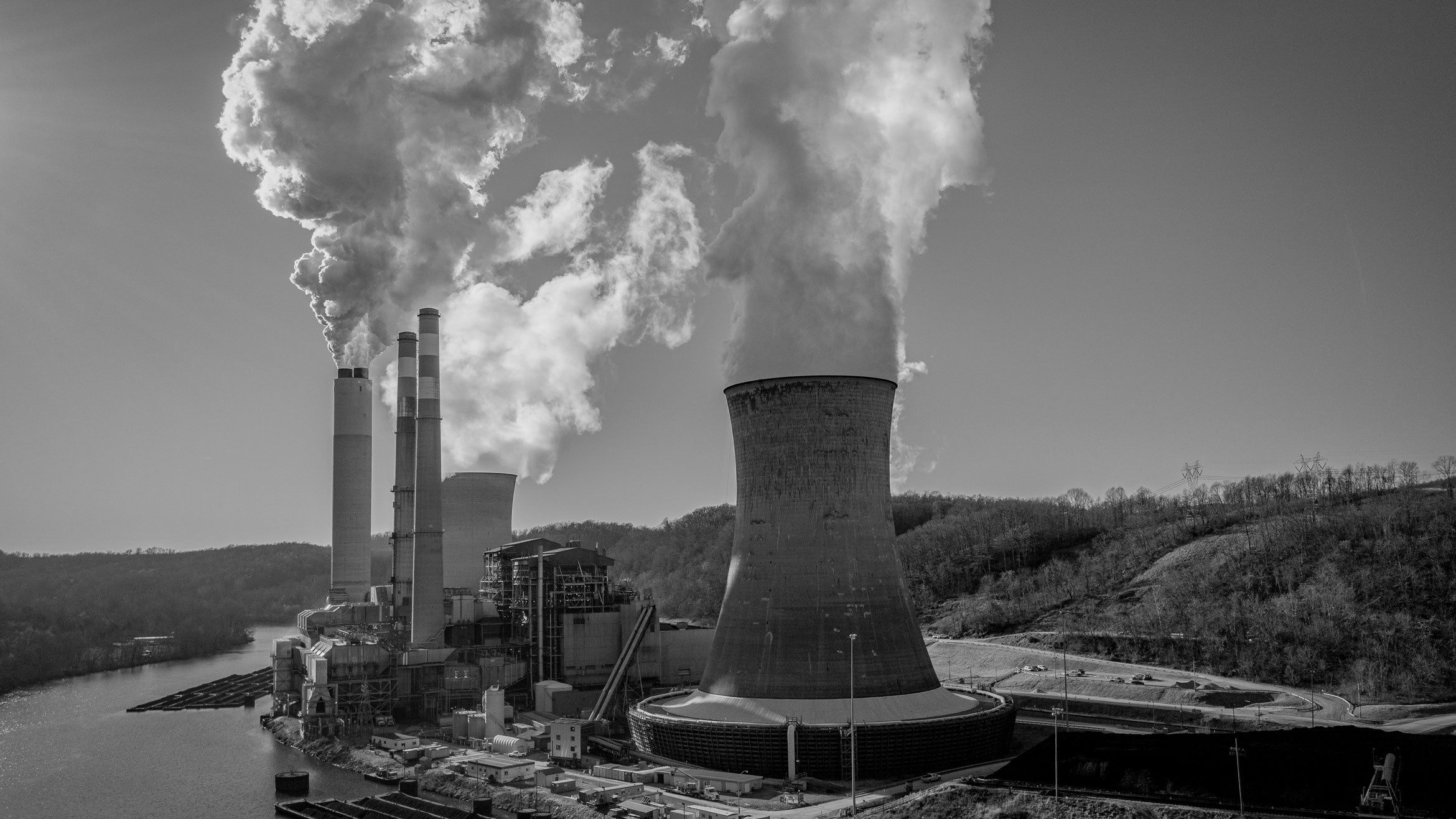Engineering at 50
As spirits ran high in the decades following World War II, a palpable feeling of optimism pulsed through the nation. Technology held vast promises for a better future, from transistors that revolutionized radio and other telecommunications to the early computer networks that would become the present-day internet.
On the West Coast, twin senses of curiosity and possibility took hold, and it was in this climate of discovery and innovation that engineering at UC Santa Barbara came into being.
And now, with curiosity and possibility still prevailing, the College of Engineering celebrates 50 years of discovery and innovation.
A College is Born
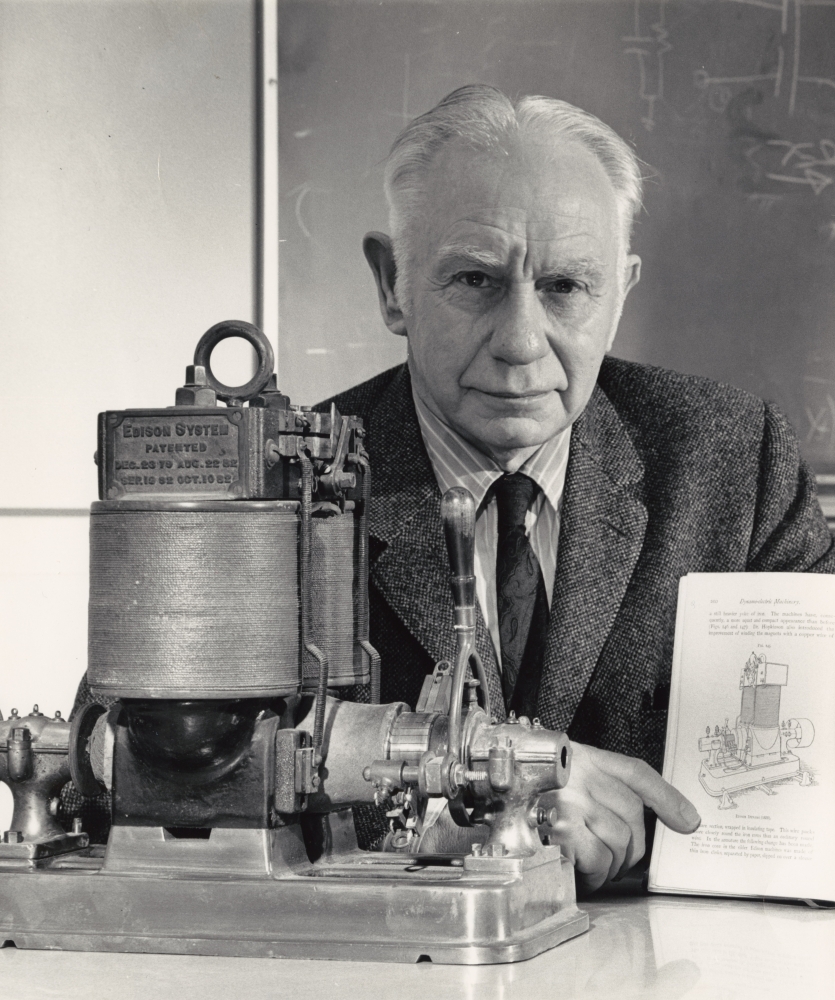
Albert Conrad, the first dean of the College of Engineering
Ohio-born Albert G. Conrad landed at UCSB by way of Yale University in 1962. An electrical engineering professor and sometime violinmaker, Conrad became the inaugural dean of UCSB’s newly established School of Engineering.
At that time, electrical engineering was the fastest-growing engineering discipline in California and on the West Coast. And it was the first department at UCSB’s fledgling engineering school, followed shortly thereafter by departments of mechanical and chemical in 1964 and 1965, respectively
But Conrad had even bigger plans. Seeing the potential of engineering education at UCSB, he lobbied then-Chancellor Vernon Cheadle in 1966 to grow the school into a College of Engineering.
“This would place it in a category with Berkeley, UCLA and Davis,” Conrad wrote in a letter to Cheadle. His request was granted and in four months the school of engineering was transformed into its own college.
“Dean Conrad was an iconic figure,” said Hua Lee, UCSB professor of electrical and computer engineering. “Students regarded him as an institution.” Often sporting green — his favorite color, Lee noted — Conrad was the kind of person who would take the time to visit with the junior members of faculty and the students.
According to Lee, such collegiality was important in the nascent days of the small college; Conrad’s vision of the great college resided not in the buildings, but in the people in it.
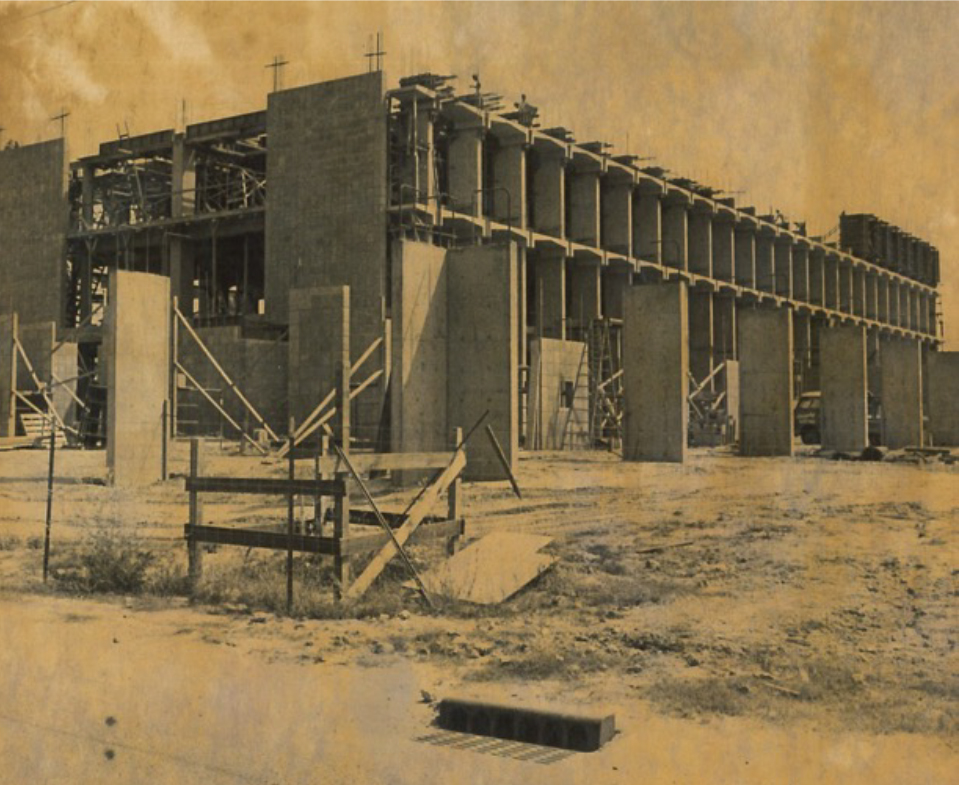
Harold Frank Hall was the first building dedicated to the College of Engineering and its academic pursuits
“For most of us, if not all, the first UCSB professor we met was Dean Conrad,” he said. Every year, he would inspire the incoming grad students with his welcome speech in room 1104 in the building that was originally known as Engineering I. “So, for us, our memory lane starts in that room with Dean Conrad.”
As engineering at UCSB grew, so did the campus. Just under half of the original Marine base buildings were still in use as teaching facilities at the time, with the rest demolished to make room for infrastructure and new buildings. Engineering classes were held in the building that now houses the departments of art and of the history of art and architecture. And though the curriculum has changed, the building still retains its engineering school roots: The ground floor functions as the dedicated machine shop for mechanical engineering students.
The Internet Before the Internet
Meanwhile, computers — bulky, mostly analog machines in the first half of the 20th century — had begun their early digital evolutions, with innovations such as stored programs and direct input via keyboard. The potential for this technology was not lost on Glen Culler, who joined the university’s Department of Mathematics in 1959. By the end of the 1960s, Culler, who had left the campus for a few years to develop an interactive computer system called the Culler-Fried Online System, had returned to UCSB to establish its first computer lab and bring the campus to the leading edge of computer science.
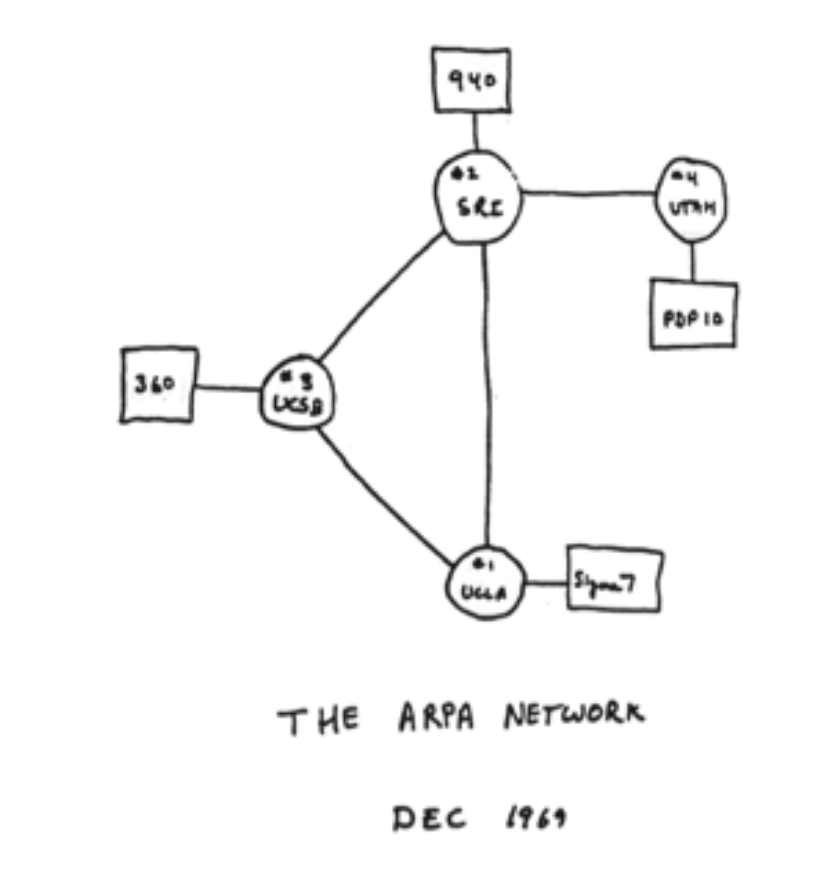
The first schematic of the ARPANET
In addition to innovations such as a user-friendly interface, a method of vector graphics and function keys, Culler’s work led UCSB in 1969 to become one of the first nodes of ARPANET, a network of computers that relied on the transmission of “packets” of information that was a project of the U.S. Department of Defense’s Advanced Research Projects Agency Network. Initially a network that included computers at UCLA, Stanford Research Institute, the University of Utah and UCSB, the number of nodes increased over the next decade, connecting computers across the country with the technology that eventually evolved into what is now the internet. Culler’s achievements would earn him a National Medal of Technology in 1999.
As computers became more accessible and versatile, they were used in more fields of research to perform calculations, to simulate physical processes, and to monitor and control real processes and experiments. The emerging field of chemical process control was initiated at UCSB in 1966 when the Department of Electrical Engineering moved into the Engineering I building (now Harold Frank Hall) and left the chemical engineers to occupy the north wing of the Arts Building for the next 20 years.
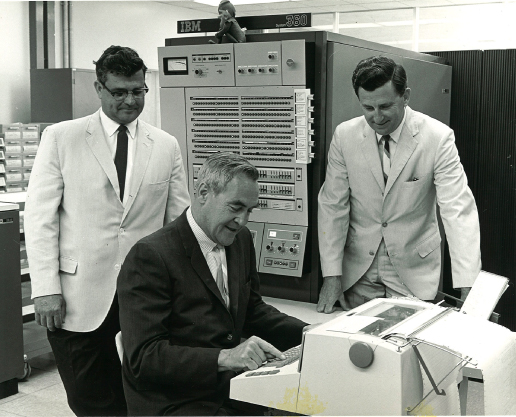
Vernon Cheadle uses a keyboard to load a program into the newly installed IBM 65, System 360, under the direction of Glen Culler and Charles Loepkey
Professor Roger Wood (of analog computer textbook fame) purchased a state-of-the-art IBM 1800 to build a hybrid computing facility for teaching and research in Engineering I. Several years later, Duncan Mellichamp, an expert in the field of chemical process control who had arrived at UCSB in 1966 following a brief career with DuPont, first used leased phone lines to link the chemical engineering department’s new experiments in his Laboratory for Process Dynamics and Control to the electrical engineering computer a half mile away.
As soon as the first new minicomputers became available at the end of the 1960s, a newly purchased Data General Nova minicomputer and financial support from the National Science Foundation made it possible to build a unique instruction and research laboratory in the developing area called “Real-Time Computing.” Several Ph.D. candidates working with Wood and with electrical engineering professor Jim Howard helped Mellichamp put the multi-disciplinary facility together to develop experiments and to begin teaching a full-year course sequence using the new lab.
“It Was an Exciting Time”
This cutting-edge technology and instruction was one element in building the campus’ reputation for interdisciplinary collaboration. The homegrown experiments, including a computer-controlled model railroad, attracted students from the departments of electrical engineering, mechanical engineering and physics, as well as from chemical engineering. A number of commercially successful start-up ventures came from those students, who turned their class and lab experiences into real-world businesses in fields involving autos, aviation, robotics, and they also became world experts in controlling large-scale manufacturing plants.
“It was an exciting time,” said Mellichamp, an emeritus professor who remains highly active with the university. Not to be deterred by the constraints of budget and the newness of the College, according to Mellichamp, he and the other founding faculty of the CoE were determined to put together a world-class program from the very beginning. “The bad news was we had nothing to start with; the good news was we had to build everything new,” he said.
Meanwhile, John Skalnik, the second dean of the College of Engineering, modified the Department of Electrical Engineering into the Department of Electrical and Computer Engineering in 1972, “to reflect the realities” of the College’s teaching and research programs. And the campus computing system, which started with an IBM 1620 computer housed in a small room in the Arts Building became a mainframe 360/370 located on the ground floor of North Hall.
Light, Lasers and Optics
It was also in the 1970s that scientists and engineers in the country began to make strides in the field of optics, or the study of the behavior and properties of light. Lasers and fiber optics emerged with their potentials to transmit information at extremely high speeds, and research — academic and commercial — bent toward developing devices that could generate and manipulate light.
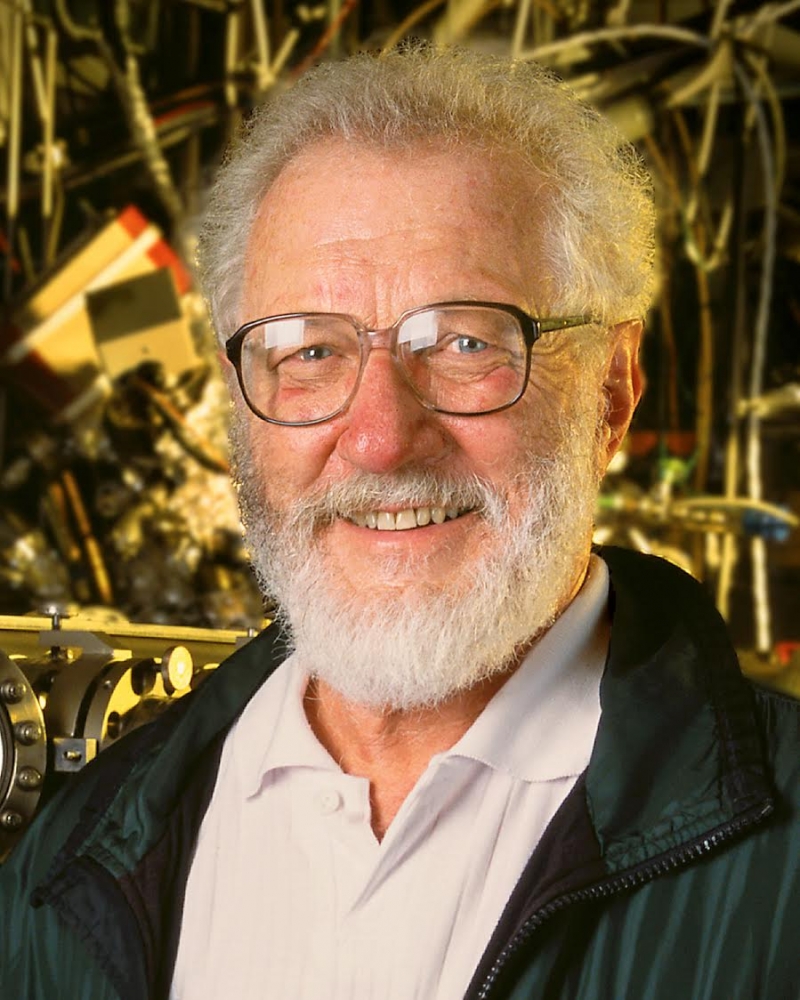
Herbert Kroemer
Halfway through the decade, a theoretical physicist — and future Nobel laureate — named Herbert Kroemer joined the faculty, bringing with him this untested notion that one could join, on the molecular level, two different materials that with their properties could control electrons and their oppositely charged “holes.” These charge carriers, if they were brought together in great concentrations, could then generate light, according to his theory of heterostructure semiconductors.
Kroemer was instrumental in bringing some of the country’s brightest scientific and engineering minds from Bell Labs to join the electrical and computer engineering faculty at UCSB. Among them was Art Gossard, an expert in the new technique of molecular beam epitaxy — a process by which materials are “grown” molecule by molecule. Gossard’s work would help prove Kroemer’s theory, which garnered the theoretician the Nobel Prize in Physics in 2000. Gossard’s work was fundamental also to a 1998 Nobel Prize for colleague Horst Störmer, and Gossard himself received the National Medal of Technology and Innovation in 2016.
By the end of the 1970s and into the 1980s, research interests in electrical and computer engineering grew and diversified such that a separate department of computer science became necessary. It would serve to address interests in the fields of programming and computation, as well as to conduct investigations into cryptography and emerging areas of cybersecurity, digital imaging and artificial intelligence.
Meanwhile, the space needs of the engineering faculty, staff and students also had grown. The College got creative with its accommodations, even renting lab and research facilities off campus. The problem was formally addressed in the 1980s with the construction of Engineering II, a large complex of engineering-specific labs and classroom space constructed to house the growing number of engineering students.
Going Small
In 1987, College of Engineering Dean Robert Mehrabian brought to the campus the Department of Materials, an interdisciplinary field that deals with the design and discovery of materials. Combining the fundamental knowledge from fields such as chemistry and physics with engineering, the discipline touches on topics of material properties to the atomic level, as well as their synthesis and processing. It was a natural progression for the College of Engineering, given the university’s tradition of interdisciplinary research, and the brainpower that already existed there. Additionally, new areas of research and industry had emerged — such as biotechnology, pharmaceuticals and nanotechnology — that demanded skills from a wide range of experts, including mechanical and chemical engineers, chemists and biologists.
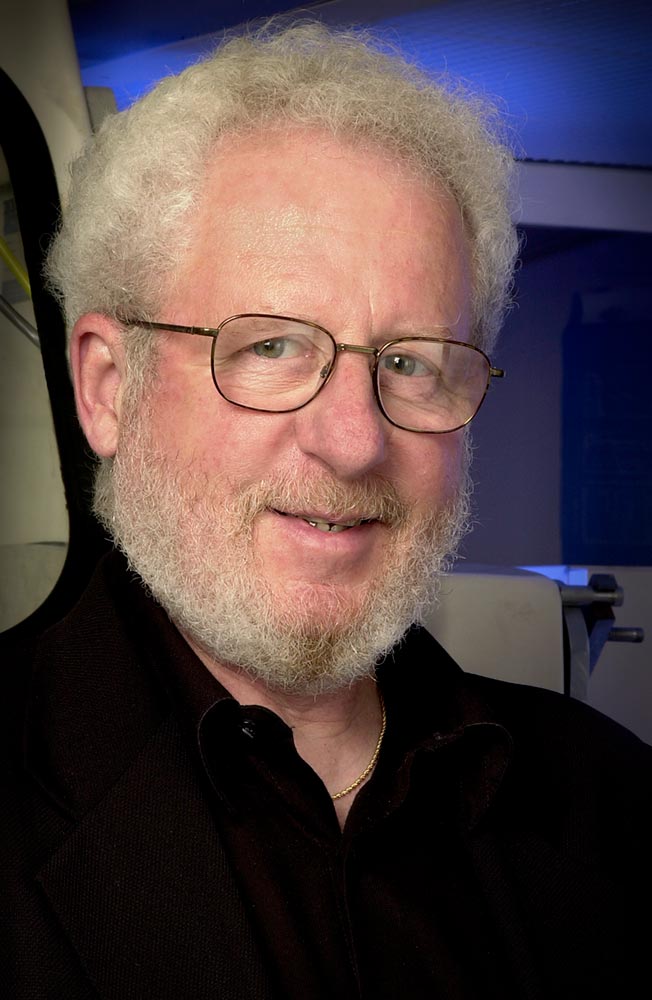
Alan Heeger
It was during this time that physicist Alan Heeger — another future Nobel laureate — joined the faculty at UCSB. He had for years, as a faculty member at the University of Pennsylvania, been pursuing the curious and intriguing (and perhaps even counterintuitive) idea that plastics could be made to conduct electricity. Working on the molecular level to modify bonds between atoms and adding select atoms to the arrangement to provide charge carriers that could support the flow of current, he pioneered the discovery and development of conductive polymers. Today that technology appears in light displays, flexible electronics and photovoltaics. Heeger was awarded the Nobel Prize in Chemistry in 2000.
The 1990s brought more developments and growth in the materials discipline at UCSB, with the establishment of the Materials Research Laboratory. It was shortly thereafter designated a federal Materials Research Science and Engineering Center, bringing together interdisciplinary groups of researchers to focus on research topics of national significance. Materials soon became one of the College of Engineering’s strongest disciplines and the department one of the consistently highest-ranked in the country.
A Collaborative Environment
Meanwhile, the College of Engineering’s fifth dean, Venkatesh Narayanamurti, had taken the helm and would steer the College toward even more collaborations, encouraging interdisciplinary research and entrepreneurial efforts. The effect of his influence would be seen throughout the campus, with the establishment of the New Venture Competition, a program meant to encourage engineers and researchers across campus to refine their entrepreneurial skills and successfully launch technology-based startups. That initiative eventually evolved into the Technology Management Program, which encompasses the new, fast-paced and constantly shifting world of ventures based on novel technologies as well as businesses that take advantage of the benefits that technology brings.
Encouraged by decades of advancements in fabrication methods, novel materials and the growing capability to inspect materials on smaller levels — and perhaps inspired as well by renowned physicist Richard Feynman’s forward-looking 1959 talk, “There’s Plenty of Room at the Bottom,” in which he predicted the emergence of molecule-sized machines — engineers everywhere began turning their attention to technology on ever-smaller scales. Microelectromechanical systems (MEMS) technology had begun to prove itself with tiny machines that could sense forces and signals with the same and sometimes better levels of performance than their macro-sized counterparts. Their versatility and cost-effective manufacture also made them popular in the marketplace, leading to early consumer applications such as airbag deployment in vehicles and accelerometers in smart phones.
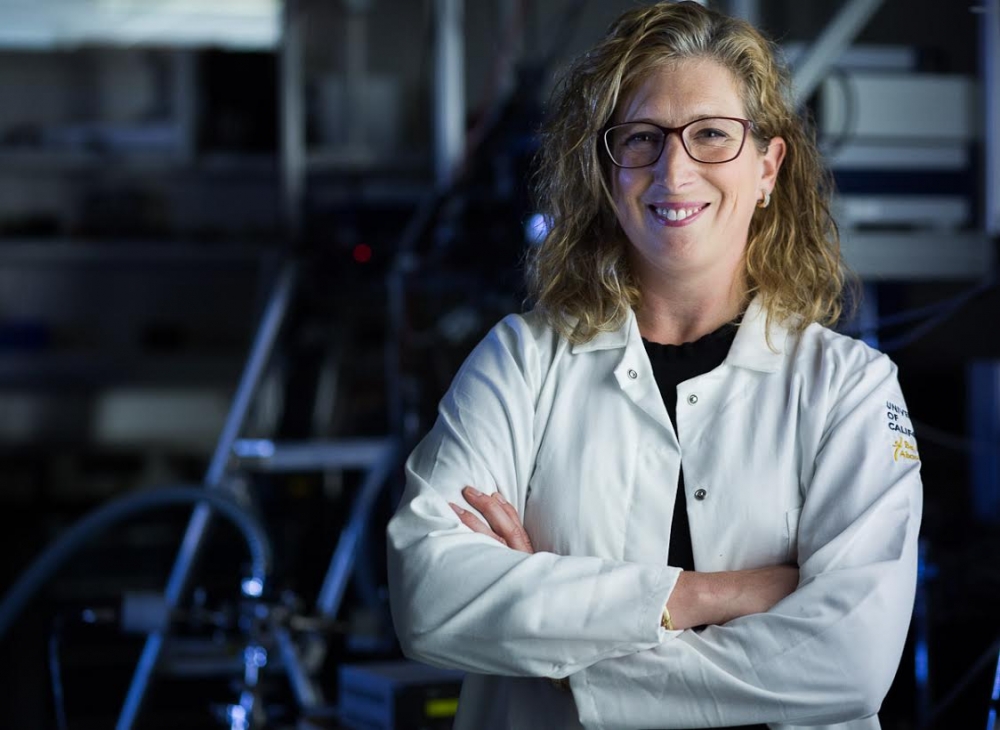
Kimberly Foster
“I was fascinated with the idea of building machines you couldn’t even see,” said mechanical engineering professor Kimberly Foster, who joined the Department of Mechanical Engineering faculty in 1999. Utilizing much of the same cleanroom space and technology on campus built for semiconductor fabrication, mechanical engineers, electrical and computer engineers, materials scientists and their collaborators explored in their research the characteristics and applications for these tiny machines with big potentials.
Matthew Tirrell, dean of the College of Engineering at that time, recognized the promising cross-disciplinary work within departments in the College, among scholarly areas in the university and alongside other institutions. He honed that integrative effort and the potential for technology to solve human problems with the spearheading of the Institute for Collaborative Biotechnologies. This set the stage for a department of bioengineering, with the hiring of faculty as well as setting in motion plans for the bioengineering building, scheduled to open later this year.
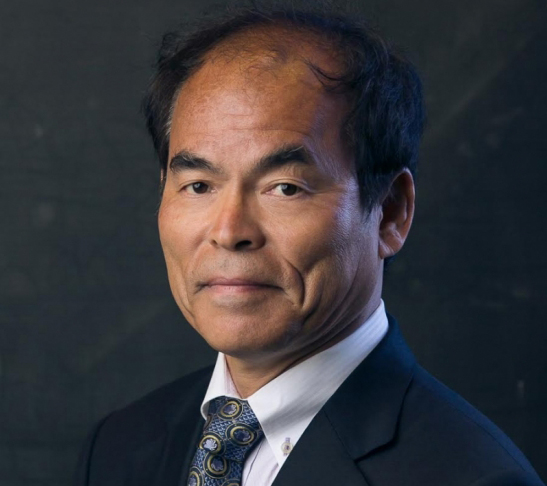
Shuji Nakamura
In 2000, Japan-born solid-state electrical engineer Shuji Nakamura — and yet another future Nobel laureate — joined the UCSB faculty. He brought with him an impressive list of technological achievements involving research and work with gallium nitride, a highly desirable yet notoriously difficult material to fabricate. Nakamura’s work resulted in the successful creation of the bright blue LED. He became a professor of materials and of electrical and computer engineering, specializing in electronic and photonic materials. His invention of the bright blue LED seven years earlier paved the way for the white LED, which since its creation has revolutionized energy efficient lighting all over the world. Nakamura received the Nobel Prize in Physics in 2014.
Addressing Emerging Issues

Engineering Sciences Building
Situating itself firmly at the center of cutting-edge technology research, the UCSB College of Engineering continues to use its considerable prowess and collaborative nature to solve the emerging problems of society. Issues such as the growing need for energy are being addressed on several fronts, with photonics research on campus advancing the technology needed to meet the demand for energy-efficient, high- performance telecommunications infrastructure. Other breakthroughs include the design of structural materials that are uncommonly strong and light — requiring less energy and materials over their life cycles to produce and less fuel to transport. Biofuels research promises alternative sources of energy from plants that will minimize competition for space between fuel crops and food crops, and solid state energy and electronics engineers continue to seek improvements to existing technology to cut down on energy waste and lay the groundwork for an advanced energy infrastructure.
Another key strength is control theory. Spanning several departments this branch of engineering impacts a wide range of systems that rely on continuous feedback, including chemical processing, drones, power grids and robotics.
UCSB engineers and researchers have tackled food insecurity as well, producing thin films that provide growers and farmers a way to cut down on food waste and extend the life of their produce, while low-cost and disposable sensor technology coupled with cloud computing is in the works to take the guesswork and waste out of farming.
Bioengineering Breakthroughs
The human body continues to be another engineering frontier. Researchers in all engineering disciplines at UCSB are taking on biology to create technologies that can potentially detect, treat and cure illnesses and treat grave injuries. Other innovations include novel drug delivery and diagnostic methods, techniques to unravel the mysteries of the brain with MEMS, and investigations into the minute mechanical cues between cells that lead to the formation of tissues in three-dimensional space.
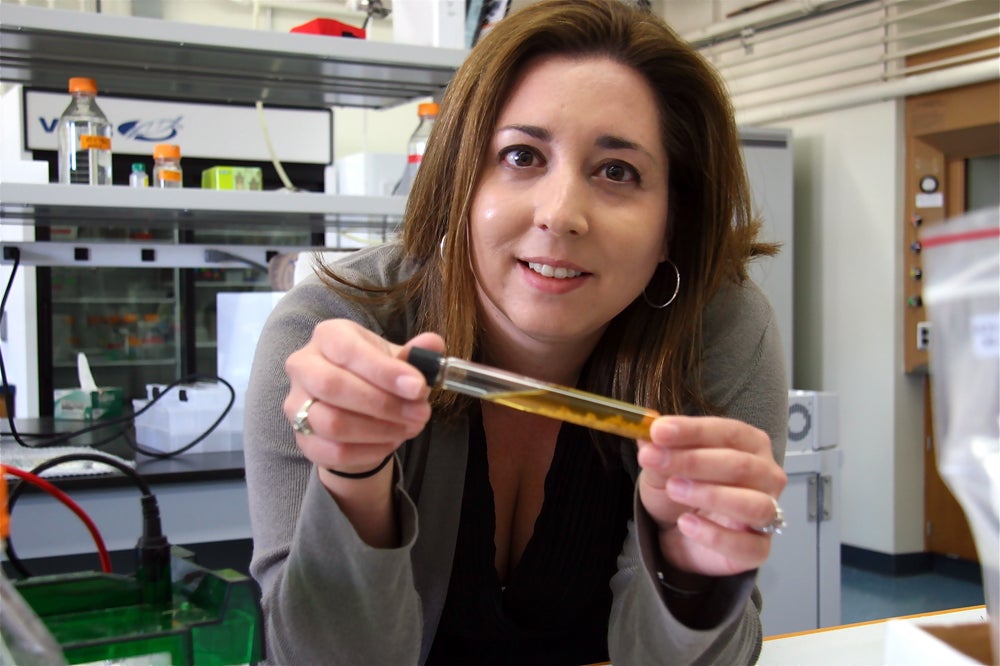
Chemical engineer Michelle O’Malley’s research examines the biotechnical potential of anaerobic microbes
“We’ve always been good at collaborations between departments, but I’m seeing that the link between biology and engineering is getting stronger,” said mechanical engineer Foster. Pairing MEMS with the also-emerging microfluidics technology, which performs molecular analyses on minute amounts of fluid, the small but powerful system allows her and other mechanical engineers along with collaborators from the life sciences to accelerate precision medicine, in which diagnostics and monitoring, and therefore treatment options and methods, are personalized to patients. Currently, the technology is at the forefront of efforts such as investigations into the response of individual brain cells to different types of forces, and real-time monitoring of the effects of drugs on the brain, or blood sugar levels in those with diabetes.
“Engineering technology is really able to contribute to those fields now,” said Foster, “and even though we don’t have a medical school, we can still make a lot of interesting discoveries and breakthroughs in those fields.”
To the Stars and Beyond
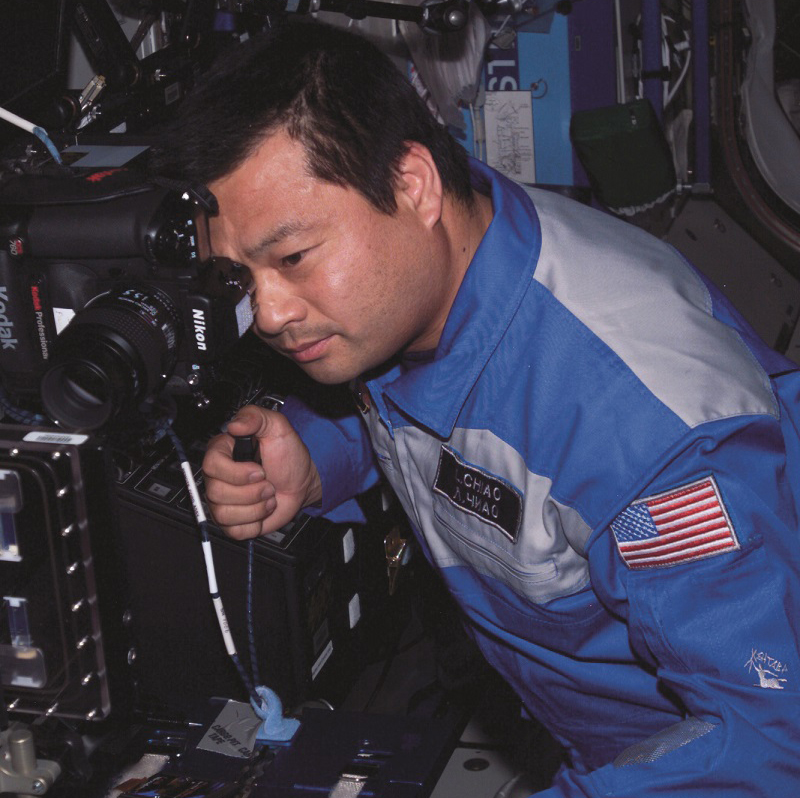
Astronaut and UCSB alumnus Leroy Chiao conducts an experiment in space
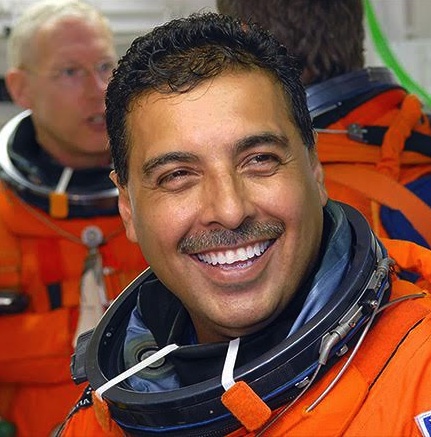
Astronaut and UCSB alumnus Jose Hernández prepares for a trip into space
UCSB-trained engineers also have gone into space. Leroy Chiao, who received his Ph.D. in chemical engineering in 1987, went on to join NASA in 1990 to become an astronaut — the first Chinese-American in space — and an International Space Station Commander. Jose Hernández, born into a family of migrant farmworkers, received his master’s degree in electrical and computer engineering from UCSB in 1986. He went on to work at Lawrence Livermore National Laboratory, where he and a colleague developed digital imaging technology for the early detection of breast cancer, as he tried out for a coveted spot on space missions with NASA. His perseverance paid off: Hernández was selected in 2008 to be a mission specialist on Space Shuttle STS-128.
Partners in Industry
To propel these, and other emerging technologies into reality, partnerships with industry as well as with government have become essential, from providing funding to initiate research and supporting innovations and out-of-the-box thinking as well as high-risk, high-reward ventures, to help with making that final leap from lab to marketplace. The College of Engineering’s partnerships are deep and wide; more industry funding comes to its engineering faculty than all but a few universities in the nation.
These working relationships have been part of current College of Engineering Dean Rod Alferness’s strategy for maintaining the College’s reputation as one of the best in the nation. Formerly the chief scientist at Bell Laboratories and Alcatel-Lucent, and senior vice president of research at Bell Labs, Alferness brings an expertise in partnering with governmental agencies and industrial partners.
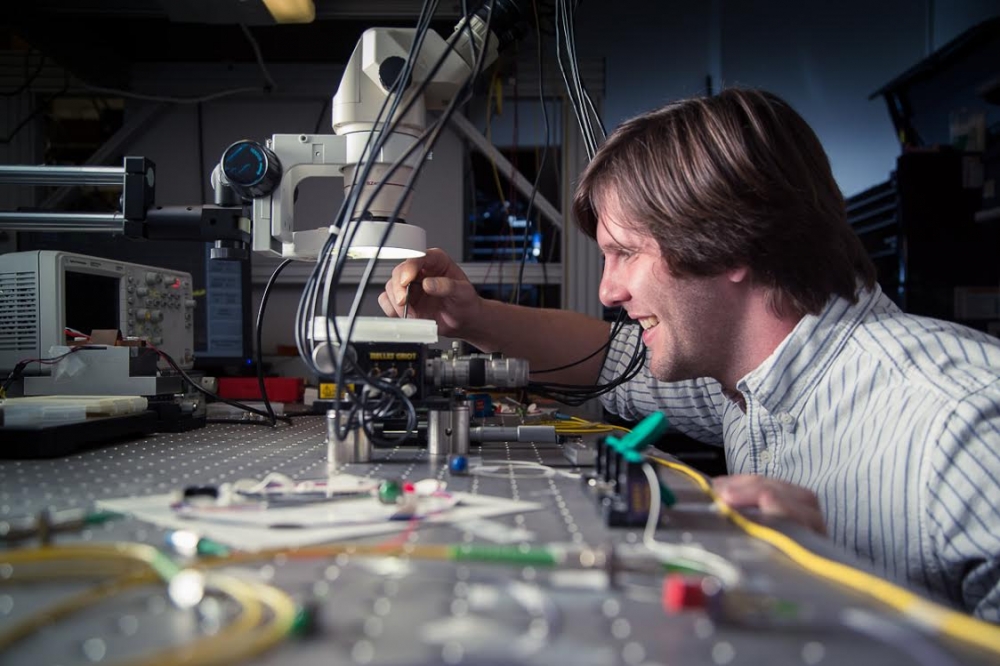
Cutting edge photonics research
This approach has resulted in benefits to faculty and students they could not have realized working in a solely academic environment. Utilizing these relationships, for example, students can not only work on relevant, real-life problems, they also can get an early taste of the industry and benefit from opportunities to build networks. In the meantime, the College does its part to address the need to maintain the nationwide level of researchers and physical scientists to keep the country at the forefront of next-generation technology.
One of the many endeavors in which these efforts are abundantly clear is in the establishment of UCSB as the West Coast hub of the American Institute for Manufacturing Integrated Photonics (AIM Photonics), a federally funded public-private partnership between industry, academia and the private sector that is not only accelerating research and development of light-based technology, but also is developing the market and creating the skilled workforce needed to implement and support it.
Here’s to the Next 50
“I’m proud to be part of the history that is the UC Santa Barbara College of Engineering,” said Alferness. “And I’m excited to have the opportunity to help guide it forward toward the next 50 years. We have made our mark and contributed for the past 50 years with the goal to produce and be engineers that benefit society. I am very confident that we will continue to play that role and do so in the years to come.”
A photographic timeline of the College’s history, from its beginnings as a School of Engineering in 1961 to the present-day AIM Photonics, can be found at engineering.ucsb.edu/history.



